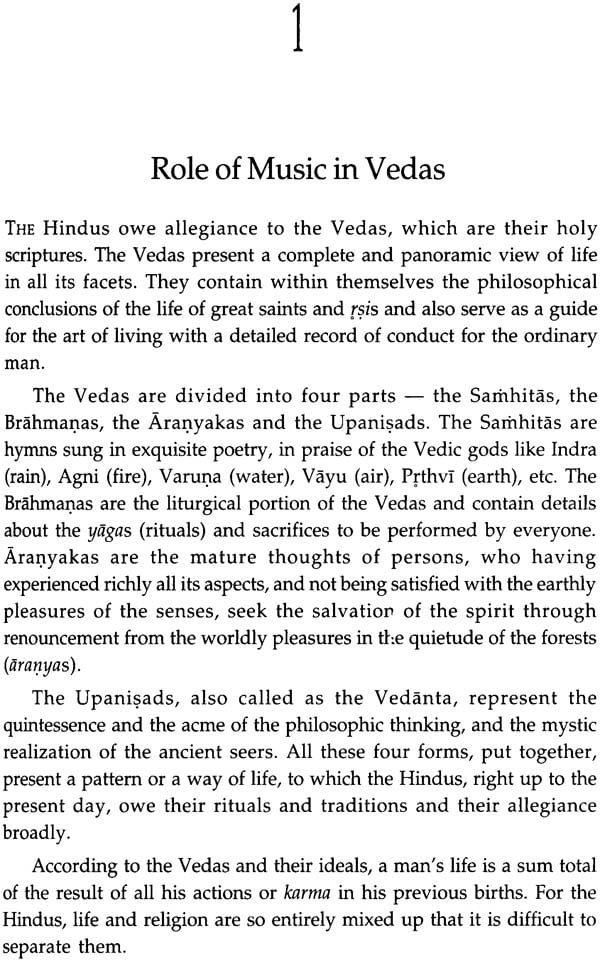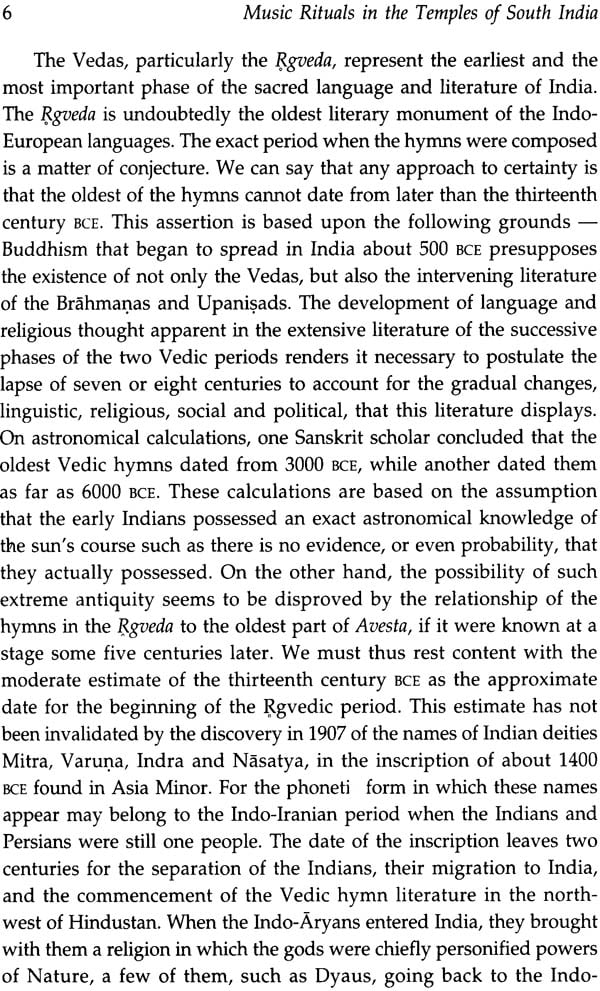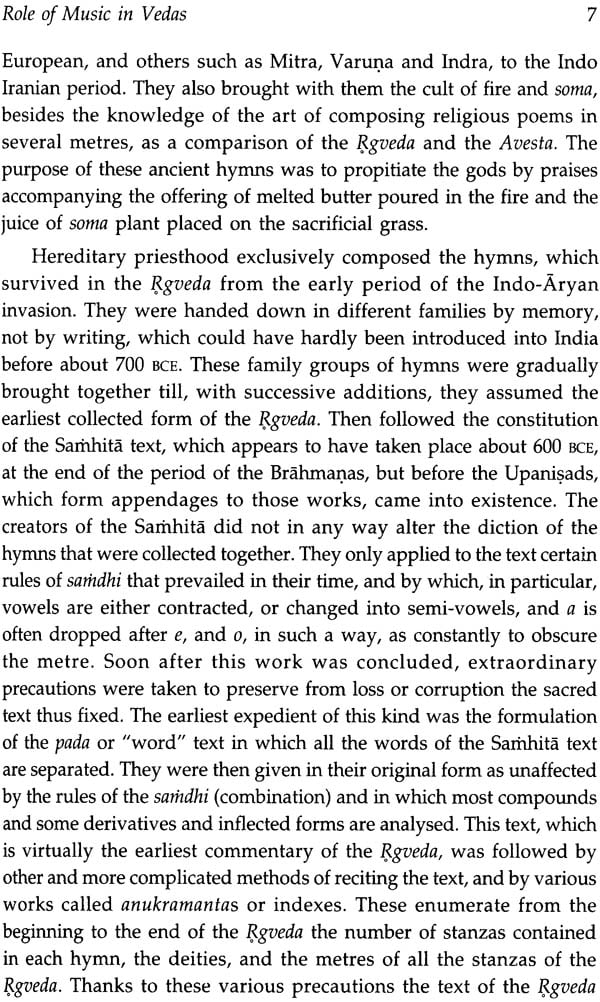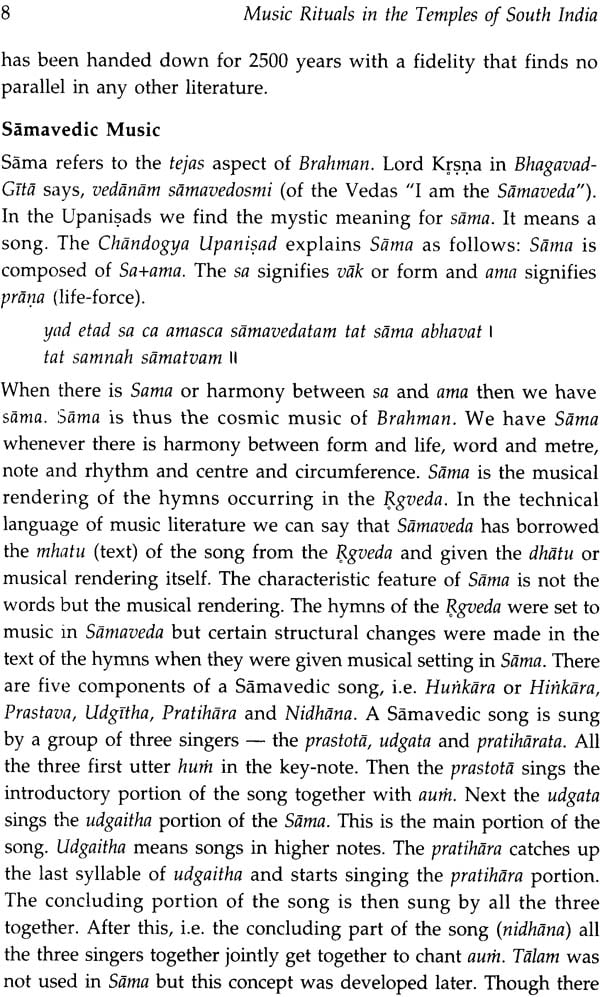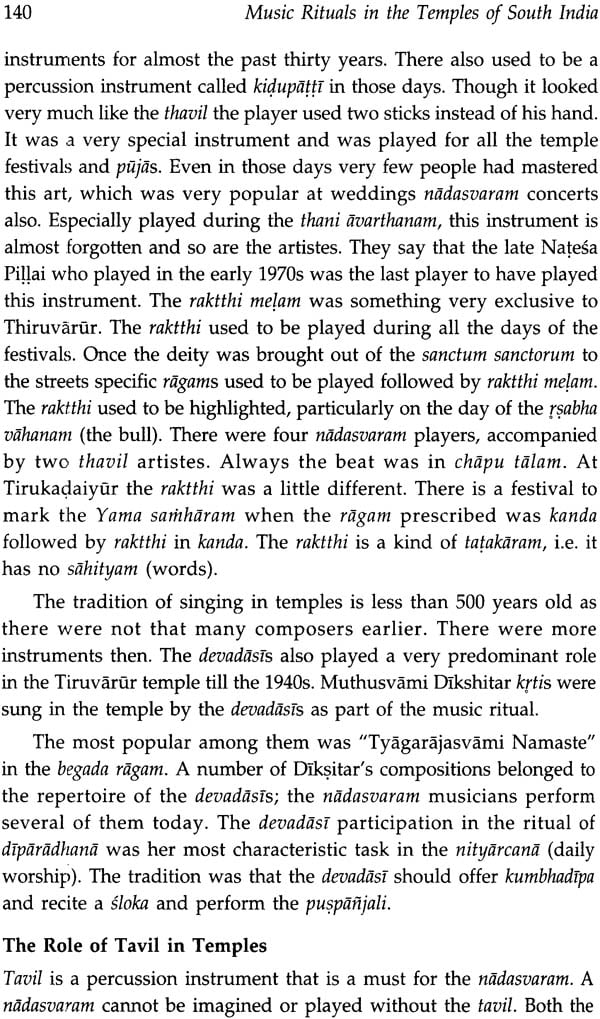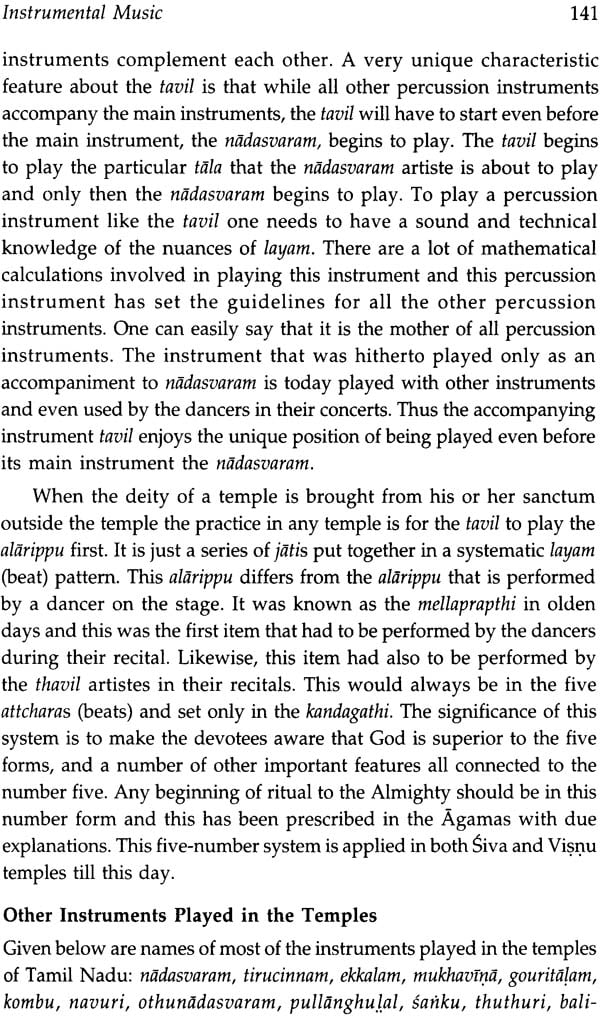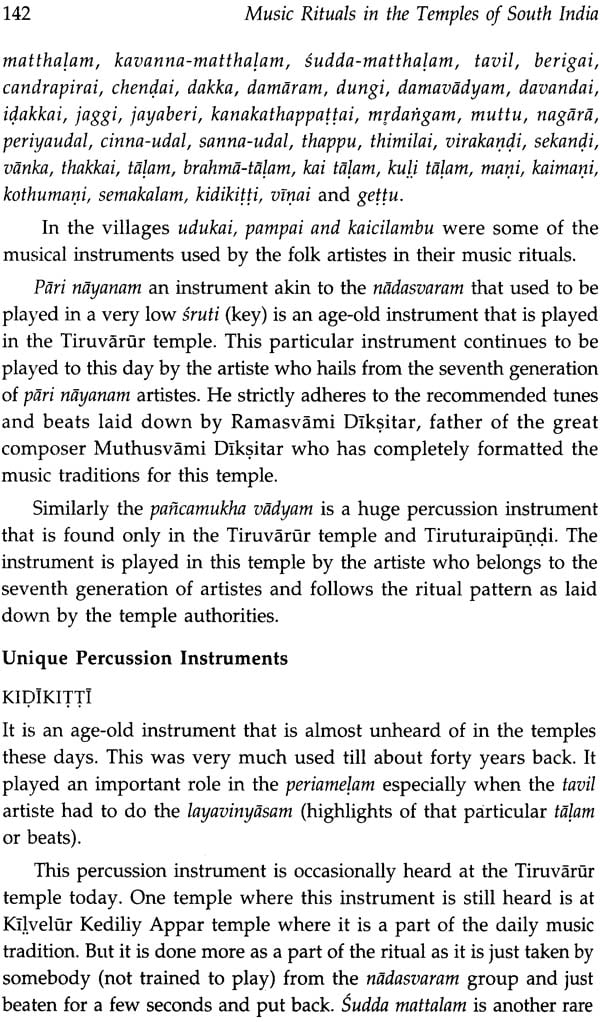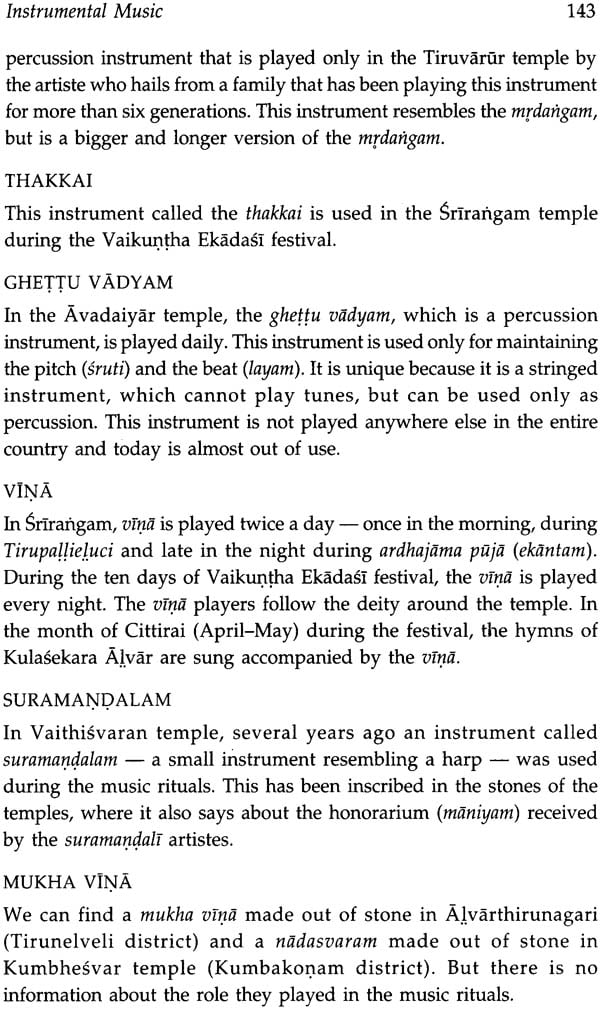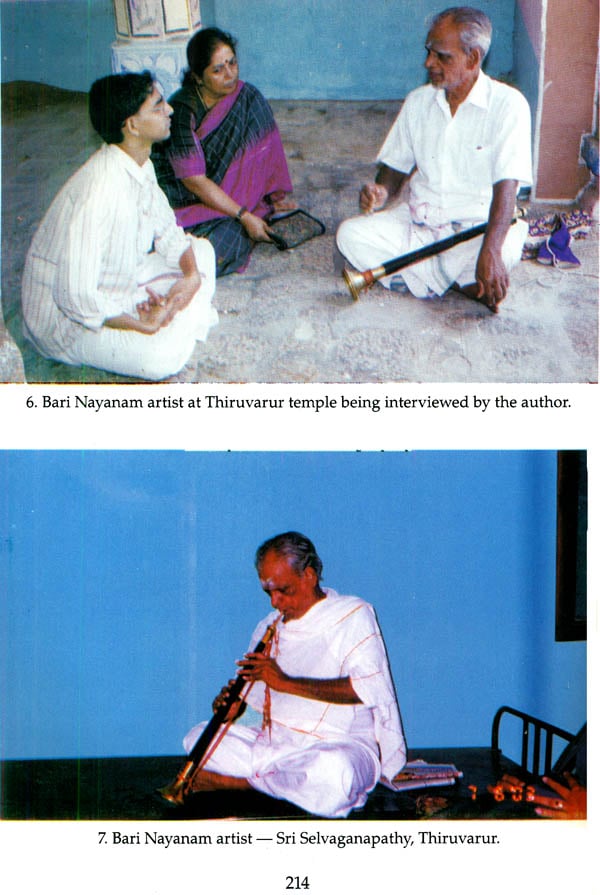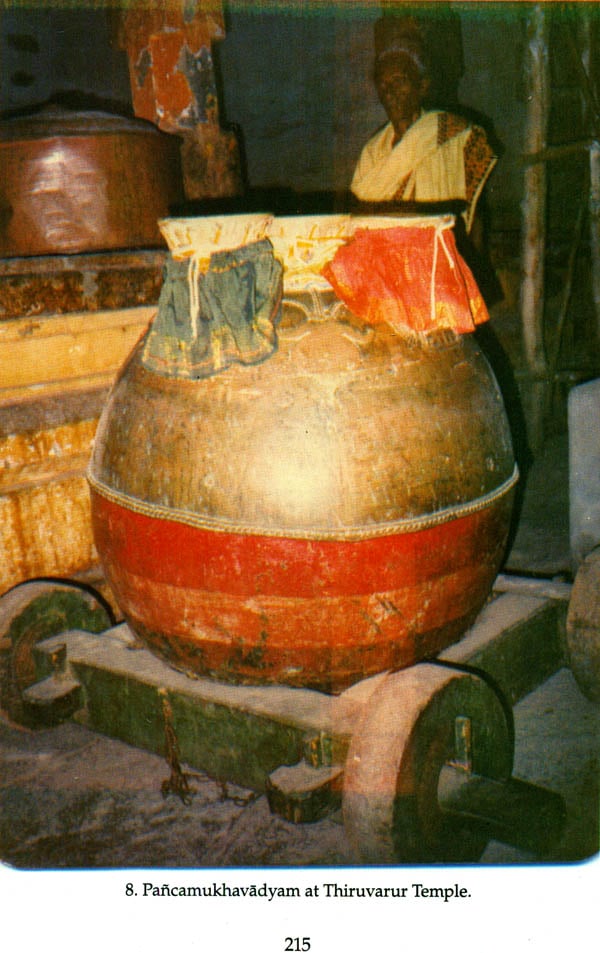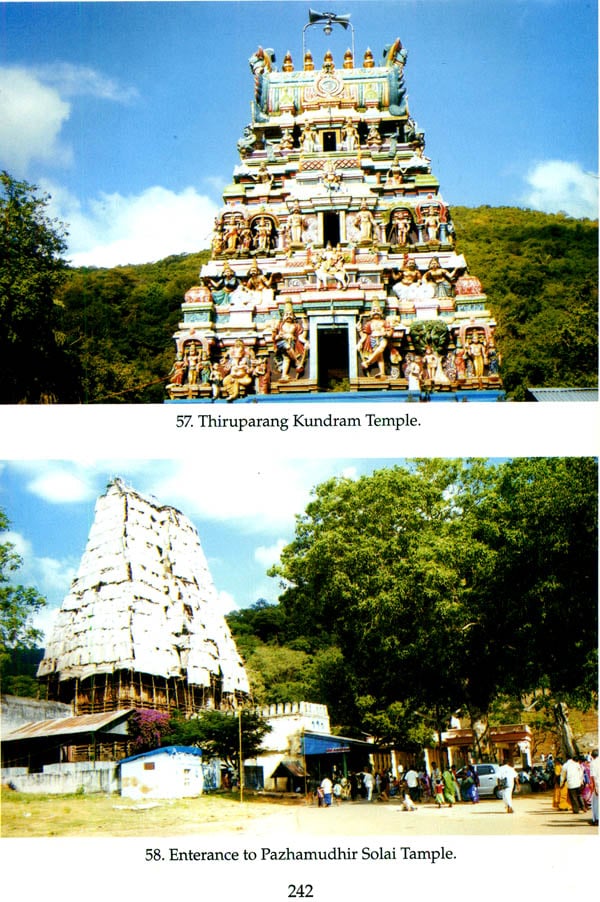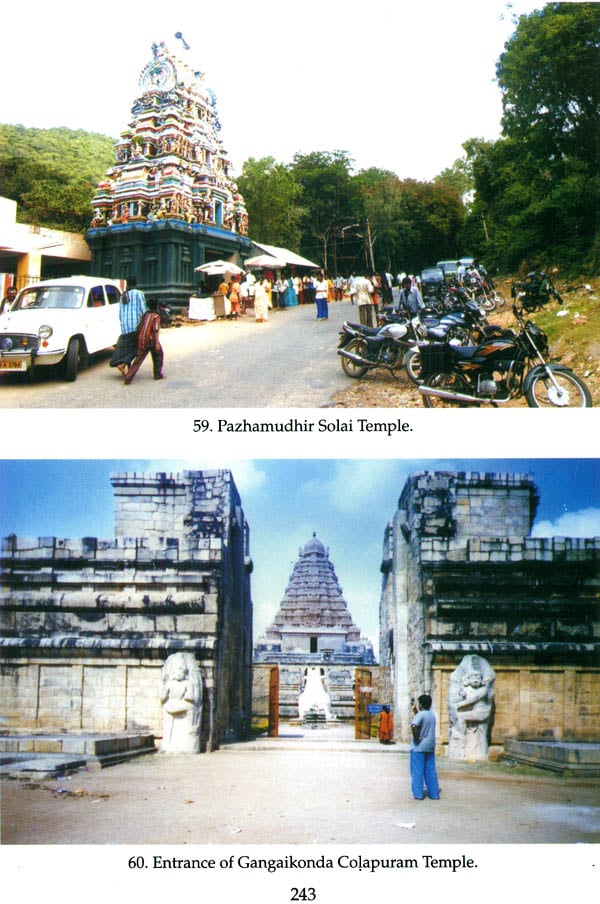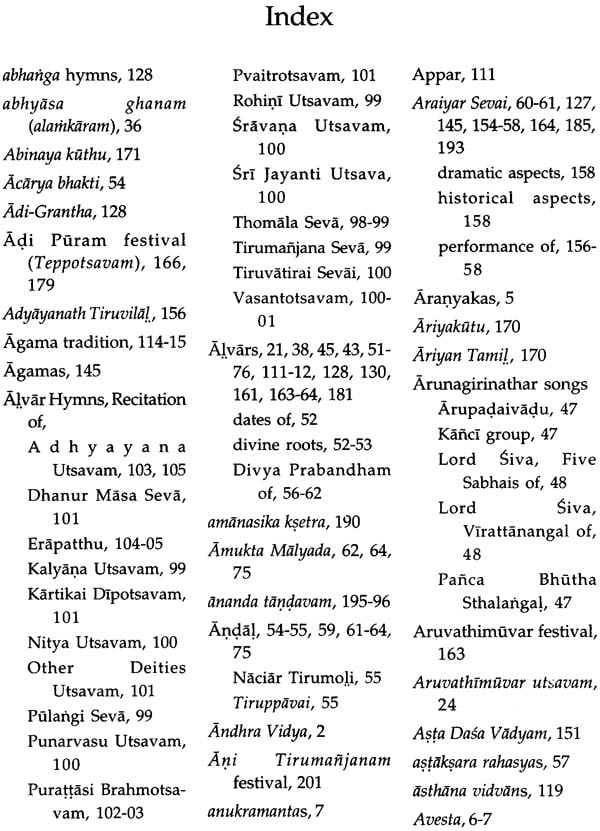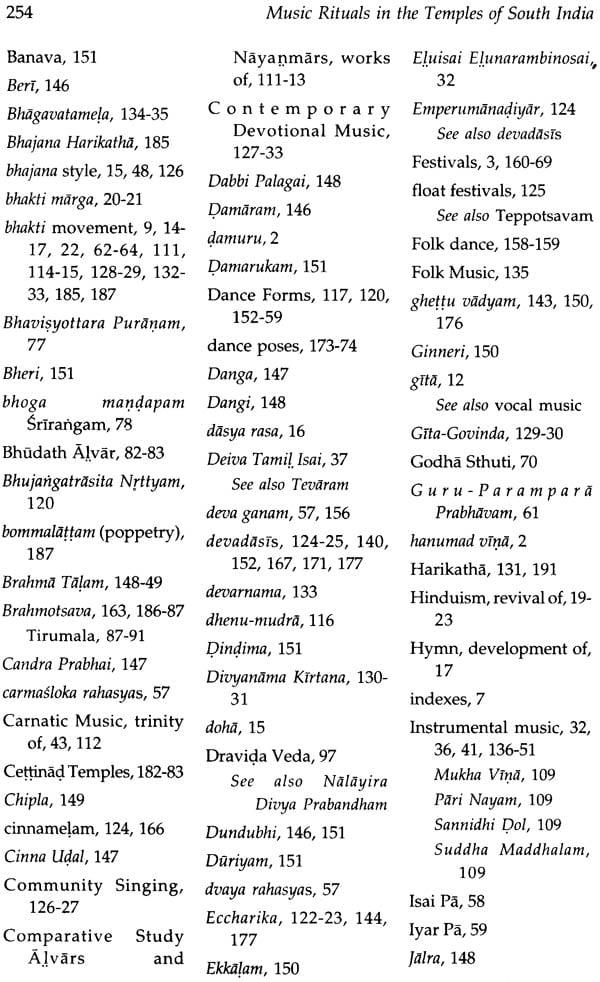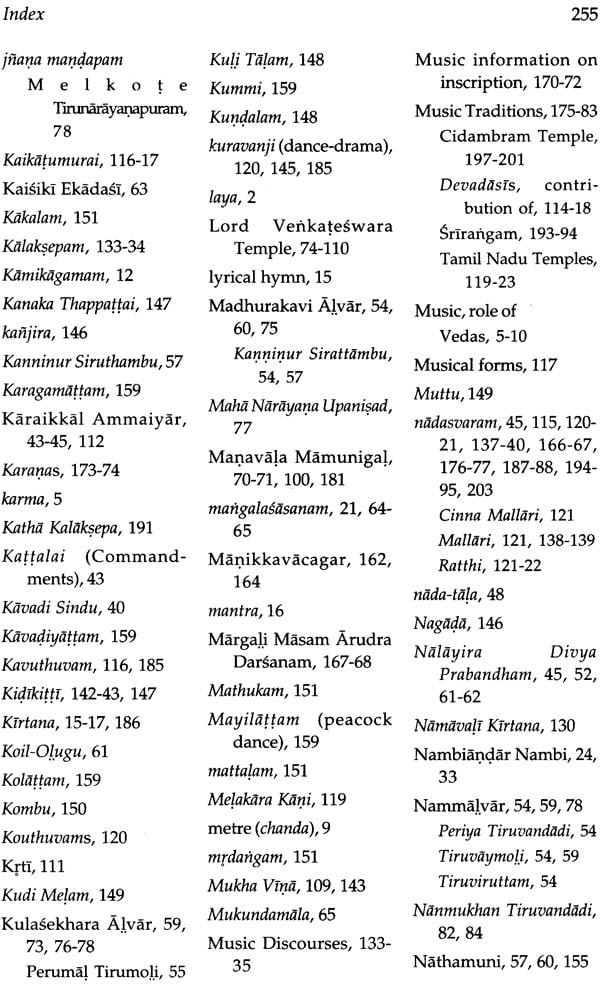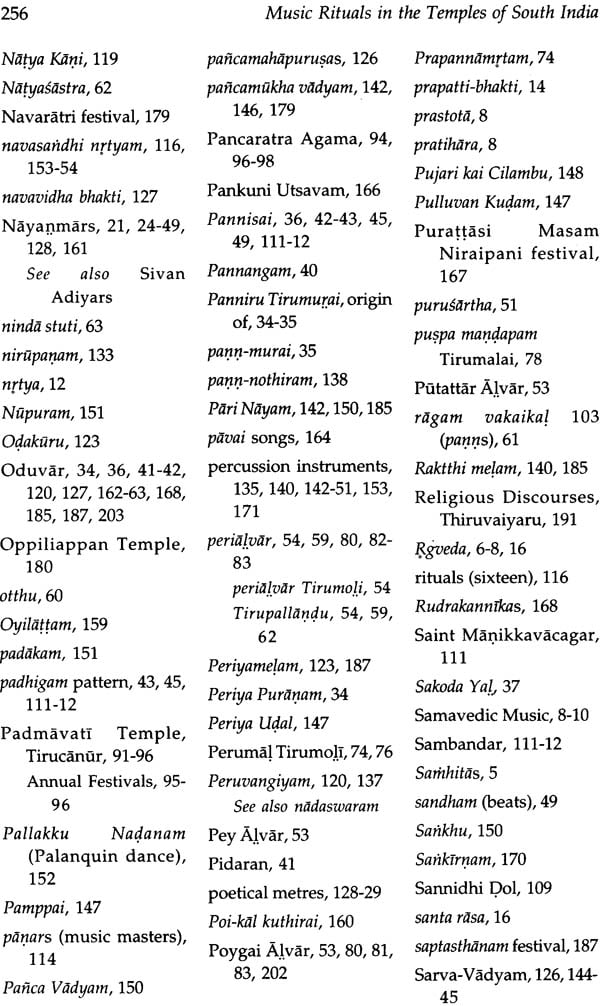
Music Rituals in the Temples of South India Vol. 1
Book Specification
| Item Code: | IDL213 |
| Author: | Geetha Rajagopal |
| Publisher: | D. K. Printworld Pvt. Ltd. |
| Language: | English |
| Edition: | 2009 |
| ISBN: | 9788124605387 |
| Pages: | 270 (8 B/W, 70 Color Illustrations) |
| Cover: | Hardcover |
| Other Details | 10.0" X 7.0" |
| Weight | 840 gm |
Book Description
From the Jacket
The book presents a wealth of information on the music rituals in temples at various places in south India. Following visits to a number of temples and based on interviews with temple artistes, the author shows that the musical traditions of temples differ from temple to temple, particularly from Vaisnavite to Saivite temples.
Beginning with the place of music in the Vedas, the book discusses music itself as a form of worship and the role of temples in promoting it. It focuses on the musical contributions of the Nayanmars and Alvars whose hymns are sung today as a daily ritual in many temples, and compares their music. It concentrates on both vocal and instrumental music, dance forms as rituals in temples, and music and singing involved in temple festivals. Many interesting inscriptions and sculptures related to dance and music have also been taken up for discussion. In a fascinating attempt, the author has dealt with unique music traditions in some temples of south India like ragas associated with specific temples only and the tradition of nadasvaram playing in Tiruvarur temple.
The volume will enthrall scholars of Indology, particularly those involved in study of religious art and music traditions.
About the Author
Geetha Rajagopal’s tryst with south Indian classical music began during her formative years in Bangalore when she quickly picked up the subtle nuances of this rich art form. She moved to Chennai after her education where she began a distinguished professional career that spanned teaching, animal rights awareness, writing (in leading journals) and finally her passion – Carnatic music. In 2000 she took over as Director of “Sampradhaya,” one of the world’s rich Carnatic music archives, and revitalized the organization with a series of programmes and workshops. She also embarked on an ambitious Sangeet Natak Akademi’s research project that put the spotlight on music tradition in south Indian temples. She has traveled extensively across south India to gather insights for her research project and continues to be actively involved with south Indian art forms and culture in her administrative role with the National Folklore Support Centre, Chennai.
Preface
A Rip to a number of temples in Tamil Nadu while doing a documentary film – “A Tryst with Trinity” – was what inspired me to take up this project. Born into a Vaisnavite family I had the opportunity of learning a number of Pasurams and the Tiruppavai at a opportunity of learning a number of Pasurams and the Tiruppavai at a very young age. I was also fortunate to learn the Tevarams and a number of Tirupugazh hymns. I sang them wherever and whenever I was asked to sing. Sadly I did not know the background of their divinity.
The documentary film on the Trinity again was an eye-opener. Before I ventured into this project I had of idea about the biographical details of the holy composers, even though I had learnt the songs of the Trinity from my seventh years. While doing the documentary, visiting a number of temples was a very divine experience. It happened to be unique as it was a musical journey (down memory lane) done by the Trinity. From my seventh year. While doing the documentary, visiting a number of temples was a very divine experience. It happened to be unique as it was a musical journey (down memory lane) done by the Trinity. During the documentation I interviewed temple artistes like the pancamukha vadyam player, the nadasvaram artistes, etc. and an interesting factor I hit upon was that the musical traditions of temples distinctly different from temple to temple, particularly from Vaisnavite to Saivite temples. That is when decided to explore further to get more facts about these rituals. Sanjay Subramanian, a leading Carnatic vocalist and also Treasurer of “Sampradaya” at that time, suggested I apply for the Senior Fellowship to Sangeet Natak Akademi. I was pleasantly surprised when I got my fellowship and then for two years it was traveling all over south India visiting one temple after another, collecting information on the music rituals.
Seeing temples in a different light and learning about the mythological background of each and every temple (the Sthala Puranam), getting to know the art forms practiced in the temple along with the regular religious rituals was an exhilarating experience and cannot be explained in a few words. It was nothing but the Divine Grace of Almighty that took me on this most wonderful journey.
Through volume one, I hope to familiarize the reader with the worship patterns of the temples in four south Indian states – Tamil Nadu, Karnataka, Kerala and Andhra Pradesh – and how music has brought humanity and God together. Volume two will be a combination of spirituality, divinity, beauty and art – worship of the Almighty and Nature and appreciation of Art. In the second volume I hope to focus on the two beautiful states – Karnataka and Kerala – in detail.
Though Andhra Pradesh has contributed immensely to Carnatic music through its composers and their songs, very little temple music rituals survive today, when compared to the other south Indian states. The nine famous Narasimha Swamy temples – the Ahobila Temple, the Mangalagiri Narasimha, Simhacalam, etc. – the famous Bhadracalam Rama temple, and the Siva temple of Srisailam will be covered with their rituals.
God’s own land Kerala with its breathtaking landscape, the beautiful sea and lofty mountains, the simple yet majestic temples – where traditions play a very significant and dominant role with a variety of art forms – classical and folk – will feature in volume two. The soul stirring music known as “Sopanam” (Astapadi singing) is a part of music ritual in a number of temples in Kerala. It has also a rich tradition of art forms like Theyyam and Thullal that continue to be part of the worship pattern in temples. Another aspect of Kerala music tradition is their instrumental music – the drum-beats – the pancavadyam and tayambaka that continue to be an integral part of the temple festivals. The world famous “Trissur Pooram” festival where the entire city vibrates with these drum-beats finds a special place in volume two.
Besides these, other art forms like Kathakali, Chakyar Koothu, Nangiyar Koothu, Tholpavai Koothu, etc. are a part of rituals practiced in temples. A special auditorium known as “Koothu-Ambalam” (performing-temple) is found in many temples where these art forms are performed on special occasions. These auditoriums mostly as old as the temples themselves help in promoting these art forms in a big way.
Coastal Karnataka where one sees nature at her best – the lofty mountains on one side, the breathtaking valleys on the other side, a gushing water fall here and there, is a feast to the pilgrim as well as the tourist. A number of temples are situated among these mountains, like Srngeri, Udupi, Mookambika, Subramanya, Kattil, etc. as we travel through the Kudremukh National Park, a long stretch of nearly 250 km.
Apart from vocal music (singing of Puranadara Dasa’s songs) instrumental music like the mukha vina, the art forms like yaksagana and puppetry give the temple traditions here a unique flavour. The “Malai-Madeswar” temple situated in the mountainous region of Kollegal district near Mysore where the “Khamsale” folk songs are dedicated to the presiding deity as a ritual, the “Araiyar Sevai” at the Melkottai temple near Mandya and some of the temples around Mysore where nadasvara traditions are followed will also feature in volume two.
It is also to be noted that in spite of the common thread of Classical music that runs through them, the local flavours of the four different states make them unique in their own way. It would give me great pleasure if the book is of use not just to a researcher or pilgrim but also to be a traveler interested in our celebrated temple history.
I feel grateful to the omnipresent to be born in India. That I belong to a country with such a rich, ancient, glorious culture makes me proud but also a little sad because I was not aware of so many traditions related not only to religion but also to art.
Working in an Archive for the past few years where we are trying our best to preserve music for posterity it is saddening to know that there is a lot of information on several art forms that are lost for lack of facilities in archiving and also the cultural changes that are forcing their way in. I felt I should present in this book some of the information I have gathered with a hope that it will inspire or at least interest a few people to visit the places I have been very fortunate to visit and see them as not only places of worship but also as places of art and culture, in short in a different light and feel proud that we belong to this country of rich cultural heritage. With a sincere and fervent hope let us try to revive or at least relive a little of this our past – a glorious one at that.
I thank the Sangeet Natak Akademi for giving me this wonderful opportunity; all the artistes of the temples; the temple priests, who with a lot of zeal and enthusiasm gave me a lot of information related to their temples; the Sampradaya Library; my colleagues Padma Viswanathan, Bharath and Govindan who gave me a lot of support, and my daughter-in-law Jyothi who traveled with me to a number of places and helped me a big way to compile.
Finally one word to all the readers – there is a popular saying in Tamil – yaan petra inbam peruka ivvaiyagam (Let this world experience the moments of happiness I enjoyed). A visit to a temple just does not en with the entry and exit from the sanctum sanctorum. I am sure if one looks beyond the gopuram of a temple one will agree with me, because there are mightier and more magnificent matters contained within other than the impressive edifice.
Introduction
We the people of India are heirs to a hoary heritage enriched and handed down o us, from generation to generation, from the dawn of civilization. Indians are welded together by strong bonds of culture, common ideals and traditions. Our history runs back to remote antiquity. Devoid of this, India is like a body without life. The backbone of Indian life is religion. Spirituality is the life-blood of this sacred land, sanctified by the footprints of great sages. This is our precious inheritance. We should strengthen these ethical and spiritual values.
The eternal fountain of our religion, philosophy, Vedas, Upanisads, Puranas and the sacred ksetras and temple have withstood the shocks and ravages of several foreign invasions and upheavals of the past. They have preserved our culture and unity. They have led to the rejuvenation of our faith. Temples express an unseen power and the presence of it. God’s manifestation in the idol is the basis of our religious worship. Many are the names of God and infinite are the forms that lead us to know Him. You will see Him in the very name and form. According to the Hindu philosophy God is sarvavyapi – omnipresent and pervades the entire Universe and can be realized in any place through prayers, anusthanas (rituals), meditation and spiritual sadhanas (practices). His presence is always more explicitly felt and realized in a temple. Therefore visits to such holy and sacred places has been our tradition that is being followed to this day. The holy pilgrimage is conducted with utmost humility, purity in thought, word and deed. Keeping this in mind our forefathers had set up time – honoured traditions, customs and tenets in the form of meditation, namasankirtana, bhajanas, reading of sacred books, satsanga, etc. these rituals were prescribed to us thousands of years ago, with the sole idea that an ardent devotee and an earnest seeker can feel the presence of God and derive much spiritual benefit.
According to Hindu mythology, music and gods have always been identified with each other. We cannot imagine any god without a particular instrument. Many of the important deities have their own instruments and are worshipped as embodiments of music or art. Lord Siva is the embodiment of nada playing the damuru and also the performer of the tandava (the cosmic dance). Lord Brahma is the origin of music inspired by Samaveda. From the world OM (the pranava mantra) the following concepts were emanated.
Sadyojatam
Vamadevam
Tatpurusam
Isanam
Aghoram
These five factors are identified as the five faces of Lord Siva and it is believed that the musical notes emanated from them and were passed on to posterity. Lord Siva was supposed to have taught these to his prime disciple and consort Parvati and from there on it was passed on to his other disciples Sage Narada, Tumburu, Nandikesvara (the mrdangam exponent) and Goddess Sarasvati, the eternal Vainka
Goddess Sarasvati, the goddess of knowledge, is always associated with the vina. Lord Krsna, the flutist, also claims that he is the Samaveda among the Vedas. Goddess Parvati is the embodiment of Iasya. Lord Visnu plays on the percussion while his consort Goddess Laksmi, the goddess of wealth is a connoisseur of music. Sage Narada can never be imagined without his thampura and he is also known as the vainkagayaka (an expert in vocal music and vina). Nandi, the bull, is the master of laya. Almost all the demi-gods like the gandharvas, the yaksas and the kinnaras are believed to be proficient in music and musical instruments. Music is also known as Andhra Vidya. Hanuman was supposed to be proficient in the instrument called hanumad vina and this is the predecuessor the present-day vicitra vina.
There has always been a perfect unison of nada with Paramatma (supreme power) and in this unison one can find the “Transcendental Power” – nadopasana. The one who created us is the Almighty. He can only be seen from within. This is the philosophy of our life, and a man who acts according to this philosophy is believed to see this Power within himself and shun suffering for himself as well as others.
Classical music and dance had a natural affinity with the temple and religion. Not only are the themes almost always religious, the performances of dance and music were carried on in temples where it was free for the public. The implication is that those who came to the temple, at least while they were within the temple, are in an elevated form of mind and do not look for cheap entertainment. Almost all the rulers (kings) in south India gave importance to the fine arts. They built many fine temples in those days (we must remember that in those days temples served the same purpose as the modern auditoriums), and patronized artistes. Traditionally a balance was struck between the king, who ruled like a feudal lord and patron, and the power of religion. All arts and sciences prospered under the wings of the temple generously supported by the king. One the other hand, the king’s holy goals i.e. to be victorious, maintain peace within his own territory, enhance rain and rich crops, were sustained by the temple priests who served in both the temple and the court.
The utsavas (festivals) are considered highly pleasing to the Lord. Various arts and crafts depend on temples and festivals. The insistence one the recitation of the sacred texts, as part of the festivals (rituals), apart from propagating them, help in preserving their form. The rituals instill in the devotee a sense of spiritual involvement either directly or indirectly. Great ritual care is taken to keep all the divine forces embedded in the temple area peaceful and content. Like a royal lord, the Divine Lord holds a court, receives visitors, listens to their requests, is awoken with the auspicious sounds of music, is bathed, dressed and amused, and, what is more important, He is emotionally involved with His devotees. One of the reasons for the many Hindu temple rituals may be the fact that this cultural religious syncretism has absorbed traditions of very divergent nature, divergent in all respects, time and social stratum.
Temples in south India particularly have played an important part in the preservation and development of music. In India, music and dance were never conceived of as mere items of entertainment. Even the greatest men and women of the land treated music and dance as subjects worthy of serious study and practice. These two arts were elevated to the status of vidya. They helped the thinking men and women to understand something of the Infinite.
AT a time when the habit of recording songs in notation was not cultivated, the only method by which the music compositions were handed on to posterity was through oral tradition. Hymn singers among the Saiva and Vaisnava saints like Seraman Perumal (circa CE 700) in Saivism and Kulasekara Alvar (circa CE 800) in Vaisnavism had sung wonderful compositions in their respective canons which are held sacred even in the present day. Temple festivals have given rise to a large number of new poetic patterns and motifs.
| Preface | vii | |
| Acknowledgement | xiii | |
| Key to Transliteration | xiv | |
| Introduction | 1 | |
| 1 | Role of Music in the Vedas | 5 |
| 2 | Music as a Form of Worship | 11 |
| 3 | The Bhakti Movement | 14 |
| 4 | The Role of Temples in Promoting Music | 18 |
| 5 | The Nayanmars | 24 |
| 6 | The Alvars | 51 |
| 7 | Temple of Lord Venkatesvara-Tirumala (Music Rituals in detail with Photographs) | 74 |
| 8 | Comparisons between the Works of Alvars and Nayanmars | 111 |
| 9 | Contribution of the Devadasis to the Temple Music Tradition | 114 |
| 10 | Music Traditions in the Temples of Tamil Nadu | 119 |
| 11 | Vocal Music | 124 |
| 12 | Instrumental Music | 136 |
| 13 | Dance Forms as Rituals in Temples | 152 |
| 14 | Festivals in Temples | 160 |
| 15 | Inscriptions of Information on Music in the Temples | 170 |
| 16 | Sculptures of Dance and Music in Temples | 173 |
| 17 | Unique Music traditions in Some Temple | 175 |
| 18 | Centres that Promoted Temple Art Forms | 184 |
| 19 | A few Important Centres to Visit | 204 |
| Conclusion | 209 | |
| Plates | 211 | |
| Bibliography | 251 | |
| Index | 253 |
